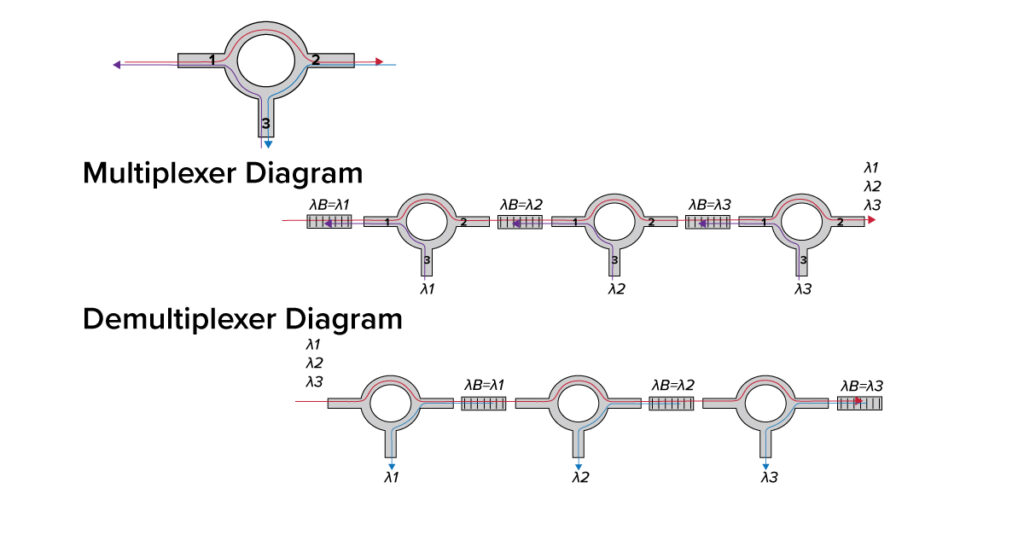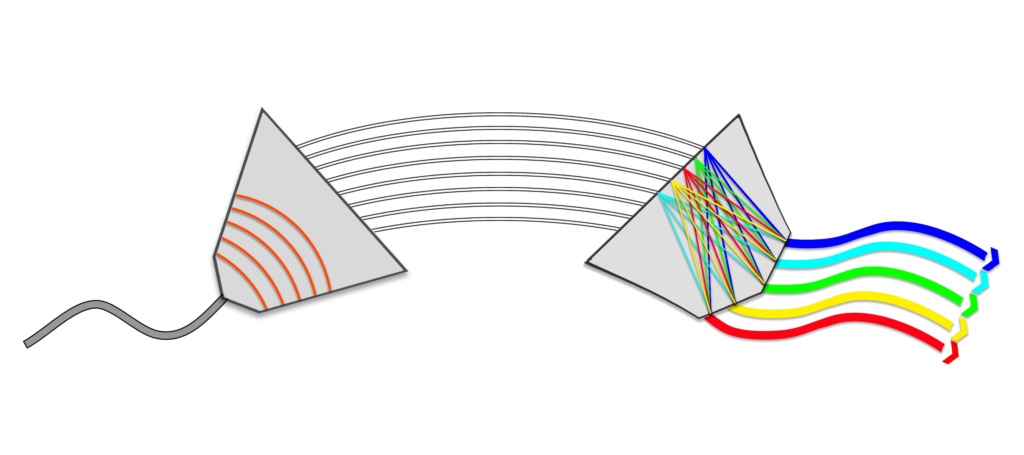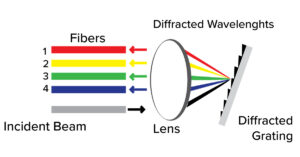
Exploring the Technologies of Multiplexing and Demultiplexing

What are multiplexers and demultiplexers?
Multiplexers and demultiplexers have 4 competing technologies upon which they are built – Fiber Bragg Grating, Array Waveguide Grating, Thin Film Filter and Diffraction Grating Filter. In this post, we examine these four technologies in greater detail, illuminating the behind-the-scenes technical aspects of making mux/demux devices work.
1. Fiber Bragg Gratings (FBG)
A Bragg Grating is a short length of fiber where the index of refraction is modulated at a periodic rate for a short length along the fiber. What this means is that for any WDM sequence {λ1, λ2, …, λB , λN}, all wavelengths other than λB will be passed through the fiber unchanged. Instead, λB will be completely reflected back to the source. (λB = 2ηeΛ where ηe is the effective refractive index in the fiber core and Λ is the grating period.) The Bragg Grating requires an optical circulator to complete the mux and demux. A circulator is a non-reciprocal 3-port optical device that passes any input signal, Si, from port Pi and outputs the signal SO = Si to port PO = (Pi mod 3) +1. For a visual description, see our Circulator Diagram.

2. Thin Film Filters
Thin Film Filters are multiple layers of very thin materials that are deposited on glass substraights. The materials are selected so that they have tuned refractive index values. Incident light is mostly reflected from the device; however, the tuned wavelength is allowed to pass through the device in either direction (this is opposite of Fiber Bragg Grating). The multiplexer has N thin film filters tuned to each wavelength. The input wavelength passes through the filter and into the output fiber. The signal is then combined with the other N-1 thin film filters as shown. Thin film technology has excellent spectral shaping at a low cost. Typically, it is used with systems of less than 40 channels. Additionally, it is bidirectional and resistant to temperature changes. Thin Film Filters are completely passive with low insertion loss.
3. Array Waveguide Gratings (AWG)
Array Waveguide Gratings consist of an optical splitter/combiner, a series of varying length fibers, and an optical coupler. The coupler has N inputs, one for each λi {I ε 1, N}. A given input is divided and presented to each of the fiber inputs (individual optical signals each having its own λi are incident to the optical coupler). From there, signals run down each variable length fiber where they end at the optical combiner. The fiber lengths for this technology are tuned such that the phase relationships of each signal constructively or destructively interfere with one another. The output of the combiner is the linearly summed signals from the input of the optical coupler.
When demultiplexing, the demux takes the mixed signal and presents it to the N varying length fibers. Because each fiber has its own tuned length, every output is phase delayed by some calculated amount. The delayed signals are then presented to each output fiber where they constructively and destructively interfere. Hence, demultiplexing occurs. Array waveguide gratings introduce polarization mode dispersion and can have high insertion loss. They are very temperature dependent and generally require temperature control to maintain proper phase relationships. AWG devices also support large channel counts and narrow channel spacing. They are suitable for larger channel numbers and have satisfactory filter response.

4. Diffraction Grating Filters
A diffraction grating filter consists of a grated lens that bends light according to its wavelength. Diffraction, unlike refraction, occurs when a wave encounters any object in free space that is compatible with its wavelength. If we assume that an incident wave reaching an obstacle (such as a slit in a diffraction grating) acts according to the Huygens-Fresnel principle, then a series of monopole radiators will be present, equally spaced according to the incident wavelength in the slit. These monopole radiators will interfere both constructively and destructively on the opposite side of the slit; this creates a pattern that is dependent upon the wavelength of the signal. Using this principle, an incident wave consisting of multiple λ’s is spectrally spread to a series of output fibers.
As demonstrated below (Figure 1.1), the center lobe contains most of the signal intensity; however, the side lobes are periodic according to the Bessel function of the first kind (J1). The argument of the Bessel function is proportional to ka, the wave number and the diameter of the aperture. If we fix the aperture size (the size of the diffraction grating), then the spread given by the Bessel function will be completely wavelength dependent (Figure 1.2 shown below in red) A diffraction grating can be built on either a transmissive or reflective material. It generally has low temperature sensitivity, is bidirectional and has low insertion loss. This technology is purely passive and supports variable channel bandwidths/large channel counts.

Partner with Precision OT
At Precision OT, our team of expert engineers specializes in manufacturing the high-quality multiplexer and demultiplexer devices needed to support advancements in fiber optic networking technology. As network operators increasingly turn to wavelength division multiplexing (WDM) technologies to increase the carrying capacity of existing fiber optic cables, we are right there to support them with reliable equipment and responsive customer services. Along with our other inventory, including static and tunable transceivers as well as fiber jumpers, our customers can find all the best products for their requirements within our ecosystem.
Regardless of your needs, you can count on Precision OT’s team to work with you to acquire the tools you need to achieve your networking goals. Because every piece of optical equipment we sell undergoes extensive testing by our in-house experts, you can be sure that you’re getting the best ROI for your mission-critical infrastructure. Best of all, our lead times are significantly shorter than those of NEMs – all due to our wide ranging in-house inventory. When deployment speed and quality are your highest priorities, Precision OT has you covered.






